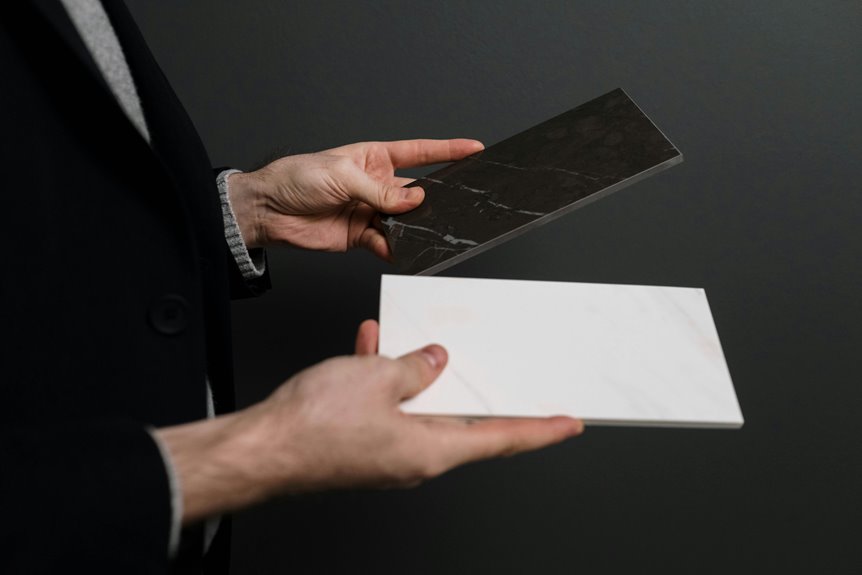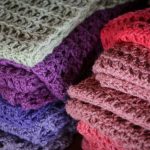If you want a smooth, suede-like fabric that’s soft, breathable, and great for cleaning or sportswear, chamois is your go-to. It’s lightweight yet warm, durable, and resists wear. Flannel, however, gives you a fuzzy, cozy texture perfect for chilly days, ideal for shirts, sheets, or blankets. It’s warmer but can pill and lose shape with washings. Keep exploring, and you’ll find out which fabric suits your needs best.
Table of Contents
Key Takeaways
- Chamois fabric has a smooth, suede-like texture, while flannel features a fuzzy, napped surface that offers more warmth.
- Chamois is durable, slightly stretchy, and moisture-absorbent; flannel is softer but prone to pilling and less elastic.
- Chamois is ideal for cleaning, polishing, and activewear; flannel is best suited for warm clothing and home textiles.
- Chamois dries quickly and resists wear, while flannel requires gentle washing to avoid thinning and loss of shape.
- Chamois combines lightweight warmth with breathability; flannel provides heavier, cozy insulation for colder conditions.
Definition and Origin of Chamois Fabric
Chamois fabric, originally made from the soft leather of the chamois goat-antelope, offers a unique combination of softness and absorbency. When you use chamois, you’ll notice its smooth texture and ability to gently clean or dry surfaces without scratching.
Historically, this fabric was crafted by tanning the hide through a special process involving oils, which gave it flexibility and water resistance. Though genuine chamois comes from animal leather, modern versions often mimic its qualities using synthetic materials.
You’ll find chamois popular in cleaning cloths, sportswear, and even cycling gloves because it handles moisture well and feels gentle against the skin. Understanding its origin helps you appreciate why chamois remains valued for its functionality and comfort in various applications.
Definition and Origin of Flannel
While chamois fabric impresses with its smooth texture and absorbency, flannel offers a different kind of comfort through its soft, warm feel.
You’ll find flannel is a woven fabric, often brushed to create a fuzzy surface that traps heat. Originating in Wales during the 17th century, it was initially made from carded wool.
Today, flannel can be crafted from cotton, wool, or synthetic fibers, making it versatile and cozy.
Picture this:
- A plaid shirt perfect for chilly autumn walks
- A thick, fuzzy blanket draped over a couch
- Soft pajamas that keep you warm all night
- A rustic flannel jacket shielding you from the cold
Flannel’s history and texture make it a go-to for warmth and comfort.
Material Composition of Chamois Fabric
You’ll find chamois fabric made from both natural and synthetic fibers, each affecting its feel and durability.
Its tight weave creates a smooth, suede-like texture that’s quite different from flannel’s fluffiness.
Understanding these material differences helps you choose the right fabric for maintenance and long-lasting use.
Natural Vs Synthetic Fibers
Although both natural and synthetic fibers serve as the foundation for chamois fabric, understanding their differences can help you choose the right material for your needs.
Natural fibers like cotton offer breathability and softness, making the fabric comfortable against your skin.
Synthetic fibers like polyester provide durability and quick-drying properties, ideal for outdoor or active use.
When you consider these options, you can picture:
- Soft, fluffy cotton fibers gently cushioning your touch
- Smooth, resilient synthetic strands resisting wear and tear
- Moisture quickly evaporating from synthetic blends
- Natural fibers allowing air to flow freely, keeping you cool
Weave and Texture Differences
Because the weave and texture directly impact how chamois fabric feels and performs, understanding their differences is key.
Chamois fabric features a tight, napped weave that creates a smooth, suede-like surface. This texture gives it a soft, flexible feel that’s ideal for absorbing moisture and providing gentle friction against the skin.
Unlike flannel, which often has a looser, brushed weave producing a fuzzier surface, chamois fabric’s weave is denser and more uniform. When you touch chamois, you’ll notice its distinctive velvety smoothness, which helps it dry quickly and stay breathable.
This specific weave not only enhances comfort but also makes chamois perfect for applications like sportswear and cleaning cloths where softness and absorbency matter most.
Durability and Maintenance
The unique weave and texture of chamois fabric contribute to its strength, but understanding its material composition will give you a clearer picture of its durability and how to maintain it.
Chamois is primarily made from natural leather or synthetic microfibers, both designed to be soft yet resilient. This combination makes chamois resistant to wear and tear, perfect for frequent use.
To keep it in top shape, you’ll want to avoid harsh chemicals and excessive heat.
Here’s what you should remember about chamois durability and care:
- Naturally strong leather fibers or durable synthetic blends
- Resistant to stretching and fraying
- Clean gently with mild soap and lukewarm water
- Air dry away from direct sunlight to prevent cracking
With proper care, chamois fabric stays durable and soft for years.
Material Composition of Flannel
Flannel combines softness and warmth through its unique material blend. Typically, it’s made from cotton, wool, or synthetic fibers like polyester, each offering different benefits.
Cotton flannel is breathable and gentle on your skin, making it ideal for everyday wear. Wool flannel provides excellent insulation, perfect for colder climates, while synthetic blends boost durability and wrinkle resistance.
You’ll often find flannel with a brushed finish, which enhances its cozy feel without altering the fiber content. Knowing the composition helps you choose the right flannel for your needs, whether you want something lightweight for layering or heavier for warmth.
Texture and Feel Comparison
When you touch chamois fabric and flannel, you’ll notice differences in surface smoothness and softness right away.
You’ll also feel a contrast in warmth and flexibility that affects how each fabric performs.
Let’s explore how these textures impact durability and comfort.
Surface Smoothness Levels
You’ll notice chamois fabric feels exceptionally smooth and almost suede-like to the touch, offering a sleek surface that glides softly against your skin. This smoothness gives it a refined, polished appearance, making it ideal for garments or accessories where a luxurious feel matters.
In contrast, flannel has a fuzzier, more textured finish that feels cozy but less sleek. Its surface is slightly napped, creating a soft nap that adds to its tactile warmth but reduces smoothness.
When you run your fingers over chamois fabric, imagine:
- Silky, velvety touch similar to fine suede
- A consistent, even surface without raised fibers
- Gentle glide without friction or roughness
- Smooth, matte finish that feels cool initially
This distinct surface smoothness sets chamois apart from flannel’s inviting but napped texture.
Warmth and Softness
While chamois fabric offers a sleek and smooth surface, its warmth and softness create a different sensory experience compared to flannel. You’ll find chamois warm yet lightweight, with a soft, suede-like feel that’s gentle on your skin. Flannel, on the other hand, envelops you in a cozy, plush texture that feels thicker and fuzzier. If warmth and softness matter most, flannel tends to provide a more comforting touch in cold conditions, whereas chamois balances softness with breathability.
| Feature | Chamois Fabric |
|---|---|
| Warmth | Moderate, breathable |
| Softness | Smooth, suede-like |
| Texture | Sleek and supple |
| Ideal Use | Mild cold, active wear |
Durability and Flexibility
Durability plays an essential role in choosing between chamois fabric and flannel, especially if you need materials that withstand regular use.
You’ll find chamois is quite tough, resisting wear and tear better than flannel, thanks to its dense weave and treated fibers.
Flannel, while softer, tends to pill and thin out over time, especially with frequent washing.
When it comes to flexibility, chamois offers a smooth, slightly stretchy feel, making it great for activewear or upholstery.
Flannel feels cozy and pliable but can lose shape if stretched too much.
Here’s what you can expect:
- Chamois resists abrasion and maintains shape
- Flannel softens but may pill after repeated use
- Chamois has a smooth, supple texture with slight stretch
- Flannel feels plush but less elastic and more prone to wear
Typical Uses and Applications of Chamois Fabric
Chamois fabric excels in tasks requiring softness and absorbency, making it ideal for cleaning and polishing surfaces without scratching.
Chamois fabric is perfect for gentle, effective cleaning and polishing without causing scratches.
When you need to dry your car or windows, chamois is your go-to material because it soaks up water quickly while leaving a streak-free finish.
You’ll also find it handy for delicate tasks like wiping down camera lenses or eyeglasses, where gentle care is essential.
If you’re into sports, chamois padding in cycling shorts offers comfort and moisture-wicking benefits, preventing chafing during long rides.
Additionally, artists use chamois for blending and smoothing chalk or charcoal, thanks to its soft texture.
Typical Uses and Applications of Flannel
You’ll often find flannel in cozy clothing like shirts, pajamas, and robes because it keeps you warm and comfortable.
It’s also popular in home textiles such as bed sheets and blankets, adding softness to your living space.
Understanding these common uses helps you see why flannel remains a favorite fabric choice.
Common Flannel Clothing
Flannel has become a staple in many wardrobes due to its versatility and comfort. You’ll find it perfect for chilly days when you want to stay cozy without sacrificing style.
Whether layering up or wearing it on its own, flannel adapts effortlessly to casual and semi-casual looks. Here are some common flannel clothing items you might want to try:
- Flannel shirts: Classic, soft, and easy to pair with jeans or leggings
- Pajamas: Warm and breathable for a good night’s sleep
- Jackets: Lightweight yet insulating for changeable weather
- Skirts: Comfortable and stylish, often paired with tights for cool seasons
You’ll appreciate how flannel garments combine softness and durability, making them go-to choices across seasons.
Home Textile Uses
Beyond clothing, flannel plays a significant role in home textiles, offering warmth and comfort where you need it most.
You’ll find flannel sheets popular during colder months because they trap heat better than many other fabrics, making your bed cozy and inviting.
Flannel also works well for blankets and throws, providing a soft, insulating layer perfect for lounging.
When it comes to home décor, flannel pillowcases and cushion covers add a touch of warmth and texture to your living spaces.
You can even use flannel for curtains or tablecloths to bring a rustic, comfortable vibe to your home.
Its durability and easy care make flannel a practical choice for everyday home use, especially when you want both function and comfort.
Durability and Care Instructions for Chamois Fabric
Although chamois fabric feels delicate, it stands up well to regular use when cared for properly. You’ll find it durable enough for everyday wear and household items, but it needs gentle handling to maintain its softness and appearance.
Chamois fabric is surprisingly durable with proper care, balancing softness and everyday usability gracefully.
To keep your chamois fabric in top shape:
- Wash it in cold water on a gentle cycle to avoid damage.
- Use mild detergent without bleach to preserve the fabric’s natural oils.
- Avoid high heat when drying; air dry or tumble dry low instead.
- Brush lightly after drying to restore its characteristic texture and suppleness.
Durability and Care Instructions for Flannel
Since flannel is made from tightly woven fibers, it offers a cozy feel while holding up well to everyday wear. You’ll find that flannel resists pilling better than some other soft fabrics, but it can still wear thin over time, especially with frequent washing.
To keep your flannel items lasting longer, wash them in cold water on a gentle cycle and avoid harsh detergents. Skip bleach and fabric softeners, as they can break down the fibers.
When drying, opt for low heat or air dry to prevent shrinking and maintain softness. If wrinkles appear, a low-heat iron works well.
Following these care tips will help your flannel stay durable and comfortable, making it a reliable choice for chilly days.
Cost and Availability Differences Between Chamois Fabric and Flannel
Taking good care of flannel helps it last, but you might wonder how it compares to chamois fabric when it comes to cost and availability.
Flannel is generally more affordable and widely available because it’s made from common fibers like cotton or wool. Chamois fabric, often made from genuine leather or microfiber, tends to be pricier and less common in stores.
If you’re shopping, you’ll find flannel easily at most fabric shops or online, while chamois might require specialty retailers.
Consider these points:
- Flannel suits budget-friendly projects.
- Chamois offers luxury but at a higher price.
- Flannel comes in many colors and patterns.
- Chamois is mostly found in niche markets or automotive supply stores.
Your choice depends on your needs and budget.
Frequently Asked Questions
Can Chamois Fabric or Flannel Be Used for Upholstery?
Did you know 75% of people prefer soft upholstery? You can use flannel for cozy seating, but chamois fabric, while durable and absorbent, isn’t ideal for upholstery due to its delicate maintenance needs and less durability.
Are Chamois and Flannel Fabrics Hypoallergenic?
You’ll find flannel is generally hypoallergenic, making it great for sensitive skin. Chamois, often treated with oils, might cause reactions. Always check fabric treatments before using either if allergies concern you.
How Do Chamois and Flannel Fabrics Perform in Moisture-Wicking?
Did you know moisture-wicking fabrics can reduce sweat by 30%? You’ll find chamois excels here, pulling moisture away quickly, while flannel absorbs more, making it cozier but less effective for staying dry during intense activity.
Which Fabric Is Better for Sensitive Skin, Chamois or Flannel?
You’ll find flannel gentler on sensitive skin because it’s soft and breathable, reducing irritation. Chamois can feel smoother but might trap moisture, which could bother sensitive skin more than flannel does. Choose wisely!
Can Chamois or Flannel Fabrics Be Recycled or Are They Eco-Friendly?
Imagine tossing a plastic bottle into recycling—easy, right? Unlike that, you can’t easily recycle chamois or flannel fabrics. They’re not very eco-friendly, so you’ll want to repurpose or donate them to reduce waste instead.
- How to Identify High-Quality Nonwoven Interfacing - July 12, 2025
- The Use of Nonwovens in Construction and Civil Engineering - July 12, 2025
- The Use of Nonwovens in Construction and Civil Engineering - July 11, 2025







